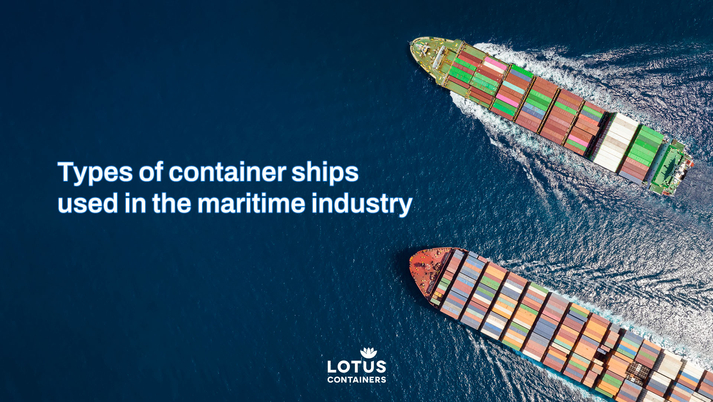The built of the various types of container ships in the maritime industry facilitate the smooth movement of goods through the canals, and channels of different sizes. Since the maximum portion of the import-export business is carried on by sea voyages, the maritime sector optimises itself to yield greater profits. The maritime industry has designed customised container ships to suit the transit of large shipments easily across long distances. These ships have made international trade much more manageable, providing passage for the blooming of the global economy.
Define container ships
Most of the global economy is driven by maritime trade. Sea transport is the most cost-effective method of shipping cargo across countries. Container ships, also known as “box ships”, are large sea vessels that aid the maritime industry in the international shipping of goods packed into cargo containers. It plays a dynamic role in balancing the demands of the supply chain through intermodal freight transport of containers by sea voyage. Based on the requirements of the type of cargo and shipping containers, there are different types of container ships to suit consumer needs.
Advantages of Container ships for transporting goods
Container ships are used worldwide to carry out profitable and sustainable trade. A few advantages of shipping via sea vessels are as follows.
- They help in carrying out environment-friendly transport. Green shipping complies with IMO guidelines and helps reduce GHG emissions and carbon footprints. Therefore, they are a preferred mode of shipping goods.
- Container ships provide flexibility in shipping all hazardous, fragile or oddly shaped cargo types. It also accommodates all sizes of containers, including heavy 53ft shipping containers.
- It is a cost-effective solution when choosing intermodal transport for international shipping.
- They can be tracked and monitored by accessing real-time data using IoT solutions.
Types of container ships
Traders may come across multiple types of container ships depending on their size, range of services, and handling mode.
- Size of container ships
(i) Panamax
– With a length of 965ft, a breadth of 106ft and a draft going up to 41.2ft, these container ships can pass the Panama Canal. It was launched in the 1980s to travel through the water-locking systems of the Panama Canal, joining the Atlantic and Pacific oceans. The storage capacity varies from 4000-5000 TEU.(ii) Post-Panamax
– It falls under the category of ultra-large container vessel. The ship has a capacity of 6400 TEU and is built to easily travel through the newly expanded locks of the Panama Canal. These ships go up to a length of 1200ft, width of 160.7ft, and a draft of 49.9ft and are most preferred among container ships.
(iii) Suezmax– The container ship has a capacity of 12000 TEU and can fit through the Suez Canal. It is smaller as compared to Panamax ships in dimensions. It is a tanker ship built to transport fuels.(iv) Malaccamax
– These custom-built container vessels allow crude oil transport through the Strait of Malacca channel. They have a storage capacity of 18000 TEU with a length of 470m, a width of 60m and a draft of 25m. - Range of services offered
(i) Mother Vessels
– It is used for internationally shipping large container fleets between major ports worldwide. The mother ship is built to cover large distances with a capacity that ranges between 10,000-15,000 TEU.(ii) Feeder Vessels
– These are smaller than mother ships and travel short distances. They operate between major and minor ports to facilitate import and export trade. Feeders also serve between smaller ports and have a 300-500 TEU capacity. - Mode of Handling
(i) Lo-Lo ships
– Abbreviation for Lift-On/Lift-Off. These ships are spacious, with empty areas on the vessel and deck to accommodate cranes on board. The cranes help in vertical loading and unloading the cargo onto the ships. It makes cabotage transport easier.(ii) Ro-Ro ships
– Abbreviation for Roll-Off/Roll-On. These ships are equipped with ramps to allow the horizontal loading of cargo containers. Cargo is loaded and unloaded by rolling off and on the containers or goods onto the container ships. It makes vehicle transportation easier.
Securing cargo containers on container ships
The shipping containers are carefully stacked and secured onto container ships to withstand the turbulence and pressure during transit.
- The stacked containers are secured in their places by inserting twist locks into the corner castings of the container.
- The bottom two layers of containers in the stack are connected to the ship with the help of lashing rods.
- If the stack is too high, lashing bridges allow workers to climb and properly lash the complete stack.
- Container stacks are arranged independently. Each vertical stack can stand independently, making it easier for vehicles to unload one stack at a time.
Difference between cargo ships and container ships
Cargo ships – All sea vessels transporting goods from one port to another are known as cargo ships. They enhance the global economy by facilitating international shipping through the maritime sector.
Container ships – They are a category of cargo ships suited mostly for carrying non-bulk cargo. Predominantly finished products are transported on container vessels of standard sizes.
The various types of container ships have made shipping even more accessible and profitable. Vessels customised to fit into sea passages are one of the best ways of reducing shipping distance and enabling on-time delivery of oversized cargo container fleets.
LOTUS Containers is a leading marketer of shipping container solutions across the world. We aid our clients with cost-effective and durable shipping containers.




